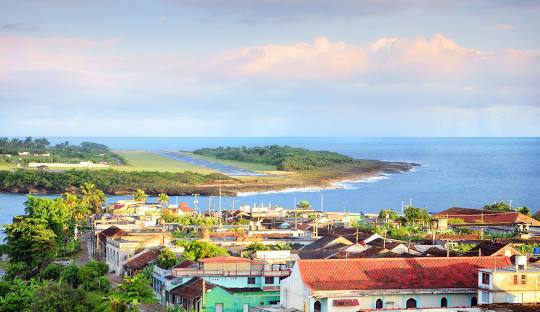



Baracoa, whose full original name is: Nuestra Señora de la Asunción de Baracoa, is a municipality and city in Guantánamo Province near the eastern tip of Cuba. Wikipedia
November to April (Dry Season):
Ideal weather (22–28°C) for hiking, beach trips, and exploring natural parks. Less rain and humidity.
May to October (Wet Season):
Hotter, wetter, and more humid — but extremely lush and green. Occasional hurricanes (especially August–October).
By Air:
Gustavo Rizo Airport (BCA) serves Baracoa with domestic flights (mostly from Havana).
By Road:
Long, scenic drive from Santiago de Cuba (~5–6 hours) via the La Farola mountain road — one of the most dramatic and beautiful routes in Cuba.
By Bus:
Viazul and local buses connect Baracoa with Santiago, Holguín, and Guantánamo.
El Yunque:
Iconic flat-topped mountain that overlooks the town — popular for hiking with panoramic views.
Playa Maguana:
Quiet, stunning beach with turquoise waters, palm trees, and snorkeling.
Parque Independencia & Catedral de Nuestra Señora de la Asunción:
Baracoa’s main square and church — peaceful and charming.
Museo Municipal:
Located in an old fort, with artifacts and history from the colonial and revolutionary periods.
Cueva del Paraíso:
A cave museum showcasing Taino petroglyphs and indigenous history.
El Yunque:
Iconic flat-topped mountain that overlooks the town — popular for hiking with panoramic views.
Playa Maguana:
Quiet, stunning beach with turquoise waters, palm trees, and snorkeling.
Parque Independencia & Catedral de Nuestra Señora de la Asunción:
Baracoa’s main square and church — peaceful and charming.
Museo Municipal:
Located in an old fort, with artifacts and history from the colonial and revolutionary periods.
Cueva del Paraíso:
A cave museum showcasing Taino petroglyphs and indigenous history.
Hiking to El Yunque with a guide through rivers and cocoa plantations.
Swim and relax at Playa Maguana or Playa Duaba.
Explore natural parks like Alexander Humboldt National Park (UNESCO Biosphere Reserve).
Sample local chocolate and visit cocoa farms.
Take boat trips on the Yumuri or Toa rivers through tropical landscapes.
Attend local music and dance nights, often held in open plazas or community centers.
Casa Particulares:
The most popular and authentic lodging in Baracoa — stay with local families, often including breakfast and dinner.
Hotels:
El Castillo (hilltop views), Porto Santo (by the bay), and La Habanera (in town center).
Eco-lodges:
Options near nature reserves or beaches for more secluded stays.
Baracoa’s cuisine is distinct and unique in Cuba, with strong Taino and Afro-Caribbean influences.
Specialties:
Cucurucho: Coconut, honey, fruit, and nuts wrapped in a palm leaf.
Pescado en salsa de coco: Fresh fish cooked in coconut milk sauce.
Cacao-based dishes and homemade chocolate.
Popular Eateries:
La Colonial, El Buen Sabor, Baracoando, and many family-run casas that serve delicious home-cooked meals.
Baracoa is Cuba’s first Spanish settlement (founded in 1511) and still preserves a small-town, soulful atmosphere.
Strong indigenous (Taino) heritage reflected in local crafts, music, and cuisine.
Known for drums, maracas, and street dances — especially during local festivals.
Friendly, welcoming people with a deep connection to nature and local traditions.